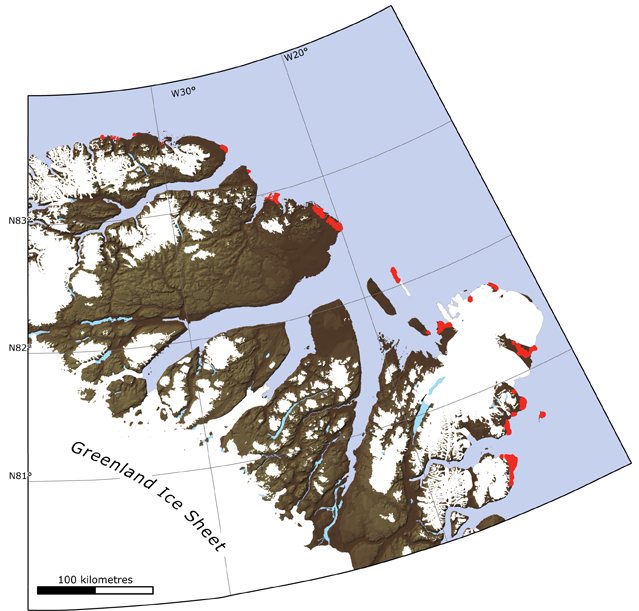Sea ice comes and goes without leaving a record so our knowledge about variations and extent was limited before we had satellite surveillance and observations from airplanes and ships. Not any more. Researchers at The Centre for Geogenetics at the Natural History Museum of Denmark, University of Copenhagen say have developed a method by which it is possible to measure the variations in the ice several millennia back in time.
Writing in Science, they show that over the last 10,000 years, summer sea ice in the Arctic Ocean has changed dramatically, and for several thousand of those years, there was much less sea ice in the Arctic Ocean than now – probably less than half of current amounts.
Team leader Svend Funder said, “Our studies show that there have been large fluctuations in the amount of summer sea ice during the last 10,000 years. During the so-called Holocene Climate Optimum, from approximately 8000 to 5000 years ago, when the temperatures were somewhat warmer than today, there was significantly less sea ice in the Arctic Ocean, probably less than 50% of the summer 2007 coverage, which is absolutely lowest on record. Our studies also show that when the ice disappears in one area, it may accumulate in another.
"We have discovered this by comparing our results with observations from northern Canada. While the amount of sea ice decreased in northern Greenland, it increased in Canada. This is probably due to changes in the prevailing wind systems. This factor has not been sufficiently taken into account when forecasting the imminent disappearance of sea ice in the Arctic Ocean.”
Since sea ice leaves no record of its own, how did they determine this? Driftwood. They organized several expeditions to Peary Land in northern Greenland, a miserable place named after American Polar explorer Robert E. Peary, where there are blizzards even during summer months.
“Our key to the mystery of the extent of sea ice during earlier epochs lies in the driftwood we found along the coast. One might think that it had floated across sea, but such a journey takes several years, and driftwood would not be able to stay afloat for that long. The driftwood is from the outset embedded in sea ice, and reaches the north Greenland coast along with it. The amount of driftwood therefore indicates how much multiyear sea ice there was in the ocean back then. And this is precisely the type of ice that is in danger of disappearing today,” Funder says.

Part of map showing the northern ice sea. The red marks illustrate beach ridges. "The good news is that even with a reduction to less than 50% of the current amount of sea ice the ice will not reach a point of no return: a level where the ice no longer can regenerate itself even if the climate was to return to cooler temperatures. Finally, our studies show that the changes to a large degree are caused by the effect that temperature has on the prevailing wind systems. This has not been sufficiently taken into account when forecasting the imminent disappearance of the ice, as often portrayed in the media,” Funder says" Credit: University of Copenhagen
Once gathered, the team needed to study the wood they had collected, collate the types and it had to be carbon-14 dated. The driftwood originated near the great rivers of present-day North America and Siberia. The wood types were almost entirely spruce, which is widespread in the Boreal forest of North America, and larch, which dominates the Siberian taiga. The different wood types therefore are evidence of changing travel routes and altered current and wind conditions in the ocean.
The team also examined the beach ridges along the coast. Today, perennial ice prevents any sort of beach from forming along the coasts of northern Greenland. But this had not always been the case. Behind the present shore long rows of beach ridges show that at one time waves could break onto the beach unhindered by sea ice. The beach ridges were mapped for 500 kilometres along the coast, and carbon-14 dating has shown that during the warm period from about 8000 until 4000 years ago, there was more open water and less coastal ice than today.
Point of no return .
“Our studies show that there are great natural variations in the amount of Arctic sea ice. The bad news is that there is a clear connection between temperature and the amount of sea ice. And there is no doubt that continued global warming will lead to a reduction in the amount of summer sea ice in the Arctic Ocean. The good news is that even with a reduction to less than 50% of the current amount of sea ice the ice will not reach a point of no return: a level where the ice no longer can regenerate itself even if the climate was to return to cooler temperatures. Finally, our studies show that the changes to a large degree are caused by the effect that temperature has on the prevailing wind systems. This has not been sufficiently taken into account when forecasting the imminent disappearance of the ice, as often portrayed in the media,” Funder says.
Citation: Svend Funder1, Hugues Goosse, Hans Jepsen, Eigil Kaas, Kurt H. Kjær, Niels J. Korsgaard, Nicolaj K. Larsen, Hans Linderson, Astrid Lyså, Per Möller, Jesper Olsen, Eske Willerslev, 'A 10,000-Year Record of Arctic Ocean Sea-Ice Variability—View from the Beach', Science 5 August 2011:Vol. 333 no. 6043 pp. 747-750 DOI: 10.1126/science.1202760





Comments